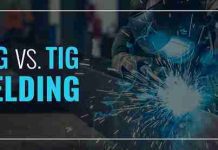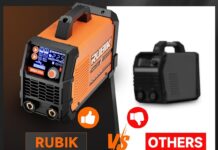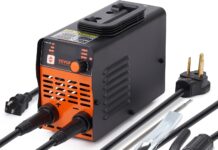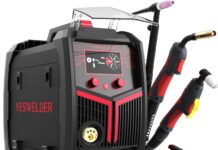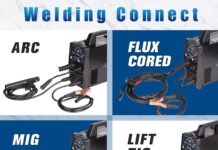Heat control is a critical aspect of achieving optimal results in welding processes. Whether you’re a seasoned professional or a budding enthusiast, understanding how to effectively manage heat input during welding is essential. In this article, we will explore the various methods and techniques that can be employed to control heat input, ensuring precise and high-quality welds. So, let’s dive right in and uncover the secrets of mastering heat control in welding!
Choosing the Right Welding Process
Understand the Different Welding Processes
When it comes to controlling heat input during welding, the first step is to understand the different welding processes available. Different processes have varying characteristics that can affect the heat input. These processes include MIG (Metal Inert Gas) welding, TIG (Tungsten Inert Gas) welding, stick welding, and flux-cored arc welding, among others. Each process has its advantages and limitations, so it’s crucial to familiarize ourselves with their specific heat input control capabilities.
Evaluate the Heat Input of Each Welding Process
Once we have a good understanding of the different welding processes, the next step is to evaluate the heat input of each process. Heat input refers to the amount of energy or heat applied to the weld during the welding process. Some welding processes, such as MIG welding, can generate higher heat inputs, while others, like TIG welding, allow for more precise control of heat input. By evaluating the heat input of each welding process, we can determine which process will provide the suitable heat input control for our specific welding application.
Select the Welding Process that Provides Suitable Heat Input Control
After evaluating the heat input of each welding process, the final step is to select the welding process that provides the suitable heat input control for our specific needs. Factors such as the material we are working with, the thickness of the material, and the desired weld quality will all come into play when making this decision. By choosing the right welding process, we can ensure that we have the necessary control over the heat input, ultimately resulting in high-quality welds.
Adjusting Welding Parameters
Determine the Optimal Welding Current
One of the most critical parameters to adjust during welding is the welding current. Welding current directly affects the heat input, and finding the optimal welding current is essential for heat input control. Too high of a current can result in excessive heat input, leading to defects such as burn-through or distortion. On the other hand, too low of a current may not provide enough heat input to create a sound weld. By determining the optimal welding current for our specific welding application, we can achieve the desired heat input and minimize the risk of defects.
Set the Appropriate Arc Voltage
Arc voltage is another crucial parameter to adjust when controlling heat input during welding. Arc voltage determines the temperature and energy of the welding arc, directly impacting the heat input. Higher arc voltages tend to increase heat input, while lower arc voltages can reduce it. By setting the appropriate arc voltage for the specific welding process and material, we can effectively manage the heat input and achieve the desired weld quality.
Control the Travel Speed
The travel speed during welding plays a significant role in heat input control. The speed at which the welder moves along the joint affects the time that heat is applied to the weld. Higher travel speeds can reduce heat input, while lower travel speeds increase it. By carefully controlling the travel speed, we can manipulate the heat input and ensure that it remains within the desired range for a successful weld.
Modify the Arc Length
Arc length refers to the distance between the electrode and the workpiece during welding. Adjusting the arc length can have a significant impact on heat input control. A shorter arc length concentrates the heat and increases the heat input, while a longer arc length spreads out the heat and decreases the heat input. By modifying the arc length according to the specific welding application, we can precisely control the heat input and achieve the desired weld quality.
Consider Preheating and Interpass Temperature Control
In certain welding applications, preheating the base metal and controlling the interpass temperature can help manage heat input. Preheating involves heating the base metal prior to welding, which can help reduce the heat input required during welding. Interpass temperature control refers to regulating the temperature between each pass during multi-pass welding. By properly preheating the base metal and controlling the interpass temperature, we can effectively manage the heat input and minimize the risk of defects.
Selecting the Proper Electrodes and Filler Metals
Choose Electrodes with Lower Heat Input Characteristics
The selection of electrodes is crucial for heat input control during welding. Some electrodes have lower heat input characteristics, meaning they require less energy to produce a weld. By choosing electrodes with lower heat input characteristics, we can reduce the heat input during welding and minimize the risk of overheating or distortion. It’s essential to consider the specific welding process and material when selecting the electrodes to ensure compatibility and achieve the desired heat input control.
Evaluate the Filler Metal Composition and Its Impact on Heat Input
Filler metals also play a significant role in heat input control. The composition of the filler metal can affect the heat input during welding. Some filler metals have higher heat input properties, while others have lower heat input properties. By carefully evaluating the filler metal composition and its impact on heat input, we can select the appropriate filler metal that aligns with our desired heat input control requirements.
Utilize Preheated Filler Metals to Control Heat Input
In certain welding applications, utilizing preheated filler metals can help control the heat input. Preheating the filler metal before adding it to the weld can reduce the heat required during the welding process. This approach can be particularly useful when working with materials that are sensitive to heat input. By utilizing preheated filler metals, we can effectively manage the heat input and achieve high-quality welds.
Using Heat Sinks and Backing Bars
Employ Heat Sinks for Heat Dissipation
Heat sinks are devices or materials used to dissipate heat during welding. They are typically placed in close proximity to the weld zone and help absorb and dissipate excess heat. By employing heat sinks, we can effectively reduce the heat input during welding and minimize the risk of overheating or distortion. Heat sinks can be made from materials such as copper or aluminum, which have excellent heat conductivity properties.
Back Weldments with Backing Bars to Absorb Heat
Backing bars are used to support and provide a solid backing for the weldment. They can also be utilized to absorb excess heat and reduce heat input during welding. Backing bars are placed behind the joint and can help dissipate heat, preventing it from affecting adjacent areas of the workpiece. By properly backing weldments with appropriate backing bars, we can effectively manage the heat input and achieve high-quality welds.
Install Proper Heat Sink and Backing Bar Designs
When using heat sinks and backing bars for heat input control, it’s essential to ensure their proper design and installation. Heat sink and backing bar designs should be tailored to the specific welding application to maximize heat dissipation and control. Improper installation or design can lead to insufficient heat input control or inadequate heat dissipation, affecting the quality of the weld. By installing proper heat sink and backing bar designs, we can optimize heat input control and achieve desired weld results.
Employing Welding Techniques for Heat Input Control
Use Pulse Welding for Precise Heat Input Management
Pulse welding is a welding technique that involves periodic and controlled current pulsations during the welding process. This technique allows for precise control over the heat input by varying the on and off time of the welding current. By employing pulse welding, we can manage the heat input more accurately, reducing the risk of overheating or distortion while achieving high-quality welds.
Implement Tack Welding to Reduce Overall Heat Input
Tack welding, or temporary welding, is a technique used to hold workpieces together temporarily before the final welding. By using tack welds, we can reduce the overall heat input required during the welding process. Tack welds only provide temporary bonding, allowing for adjustments and alignment before the final weld. By implementing tack welding, we can minimize the heat input while ensuring proper joint fit-up and alignment.
Opt for Sequential Welding in Thick Sections
Sequential welding involves dividing a weld into smaller sections and welding them sequentially. This technique is particularly useful when working with thick sections or large weldments. By welding smaller sections at a time, we can control the heat input more effectively, avoiding excessive heat build-up or distortion. Sequential welding allows for better heat distribution and management, resulting in high-quality welds with controlled heat input.
Applying Welding Positioning and Techniques
Utilize Vertical Welding for Heat Input Control
Vertical welding, also known as up welding, is a technique where the weld joint is positioned vertically, and the welding progresses upwards. This technique can provide better heat input control as gravity helps to distribute the heat and prevent excessive build-up. By utilizing vertical welding, we can maintain the desired heat input and minimize the risk of distortion, particularly when working with materials prone to heat-related issues.
Employ Horizontal Welding Techniques to Manage Heat Input
Horizontal welding techniques involve welding on a horizontal plane, with the weld progressing horizontally. Employing horizontal welding techniques can help manage heat input, especially when welding thin or heat-sensitive materials. By welding horizontally, we can control the heat input more effectively, preventing excessive heat build-up and achieving high-quality, distortion-free welds.
Implement Welding Positioners and Manipulators
Welding positioners and manipulators are mechanical devices that facilitate the movement and positioning of the weldment during welding. These devices can be particularly useful when controlling heat input, as they allow for precise control over the welding position and movement. By utilizing welding positioners and manipulators, we can effectively manage the heat input, ensuring consistent and high-quality welds.
Managing Joint Preparation and Fit-up
Ensure Proper Joint Fit-up to Minimize Heat Input
Proper joint fit-up is crucial for heat input control during welding. By ensuring a proper fit-up between the workpieces, we can minimize the heat input required to fill gaps or uneven joint surfaces. A tight and precise joint fit-up allows for better control over the heat input, resulting in high-quality, defect-free welds.
Use Appropriate Joint Geometry and Gap Control for Heat Management
The geometry and gap between the joint surfaces can significantly impact heat input during welding. By selecting appropriate joint geometry and controlling the gap, we can manage the heat input more effectively. Convex or concave joint geometries can affect the distribution of heat, while excessive gaps can require increased heat input. By carefully considering the joint geometry and controlling the gap, we can achieve the desired heat input and minimize the risk of defects.
Apply Welding Techniques to Manage Groove Shape and Heat
Groove shape and preparation are essential factors for heat input control. Different groove shapes or edge preparations can affect the heat input required to achieve a sound weld. Varying the groove shape, such as V-groove or U-groove designs, can help manage the heat input by providing better access for the welding arc. By applying appropriate welding techniques to manage groove shape and heat, we can optimize heat input control and achieve high-quality welds.
Controlling Heat Source Distance
Maintain Optimal Arc Length for Desired Heat Input
The distance between the electrode and the workpiece, known as the arc length, directly affects the heat input during welding. Maintaining an optimal arc length is crucial for controlling heat input. Too short of an arc length can concentrate the heat, increasing the heat input and potentially causing issues such as burn-through. Conversely, too long of an arc length can spread out the heat, reducing the heat input and potentially causing incomplete fusion. By consistently maintaining the optimal arc length, we can control the heat input and achieve desired weld results.
Monitor the Position of the Heat Source during Welding
Keeping a close eye on the position of the heat source, such as the welding arc, is essential for heat input control. Maintaining a consistent position and movement of the heat source ensures uniform heat distribution and minimizes the risk of overheating or underheating. By monitoring the position of the heat source throughout the welding process, we can effectively manage the heat input and achieve high-quality welds.
Prevent Heat Source Deflection with Proper Techniques
Heat source deflection refers to the deviation or misalignment of the welding arc during welding. Heat source deflection can lead to uneven heat distribution and an inconsistent heat input. By employing proper techniques, such as steady hand movement and maintaining proper electrode angles, we can prevent heat source deflection. By preventing heat source deflection, we can control the heat input more effectively and achieve consistent, defect-free welds.
Implementing Shielding and Gas Control
Choose and Control the Shielding Gas Composition
Shielding gas composition plays a crucial role in heat input control during welding. Different shielding gas compositions can have varying effects on the heat input. Some shielding gases, such as argon, can provide excellent heat dissipation properties, reducing heat input. On the other hand, other shielding gases, such as helium, can increase the heat input due to their higher thermal conductivity. By carefully choosing and controlling the shielding gas composition, we can effectively manage the heat input and achieve desired weld results.
Select the Appropriate Flow Rate for Shielding Gas
In addition to the composition, the flow rate of the shielding gas also affects the heat input during welding. Insufficient gas flow can lead to inadequate shielding and higher heat input, while excessive gas flow can waste gas and potentially affect heat input control. By selecting the appropriate flow rate for the specific welding process and material, we can optimize heat input control and achieve high-quality welds.
Utilize Gas Cups and Nozzles for Heat Control
Gas cups and nozzles are accessories that help control the flow and direction of the shielding gas during welding. By utilizing the appropriate gas cups and nozzles, we can achieve better control over shielding gas distribution and heat input. Gas cups and nozzles with appropriate sizes and designs can help direct the shielding gas precisely where it is needed, optimizing heat input control and ensuring high-quality welds.
Monitoring and Measuring Heat Input
Use Heat Input Monitoring Devices
Heat input monitoring devices, such as heat input meters or monitors, are invaluable tools for controlling heat input during welding. These devices measure and display the total heat input applied to the weld, allowing us to monitor and adjust as needed. By utilizing heat input monitoring devices, we can actively track the heat input and make real-time adjustments to achieve the desired heat input control and ensure high-quality welds.
Employ Thermocouples and Temperature Monitoring Techniques
Thermocouples and temperature monitoring techniques provide additional means of monitoring and measuring heat input during welding. Thermocouples are temperature sensors that can be strategically placed to measure the temperature at specific points in the weldment. By employing thermocouples and temperature monitoring techniques, we can gain valuable insight into the heat distribution and adjust the welding parameters accordingly for optimal heat input control.
Measure and Record Critical Parameters
To ensure accurate heat input control and maintain a record of the welding process, it is essential to measure and record critical parameters. Parameters such as welding current, arc voltage, travel speed, and interpass temperature should be measured and recorded systematically. By measuring and recording these critical parameters, we can analyze the data to identify any deviations or trends that may affect heat input control. This information can then be used for process optimization and quality control purposes.
In conclusion, controlling heat input during welding is crucial for achieving high-quality welds and minimizing the risk of defects. Through a combination of understanding different welding processes, adjusting welding parameters, selecting appropriate electrodes and filler metals, utilizing heat sinks and backing bars, employing welding techniques, managing joint preparation and fit-up, controlling heat source distance, implementing shielding and gas control, and monitoring heat input, we can effectively control the heat input throughout the welding process. By following these practices, we can ensure successful welds with the desired quality and integrity.



